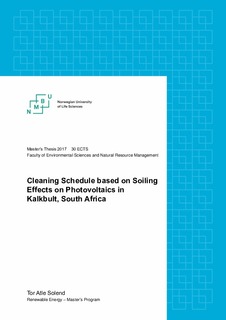| dc.contributor.advisor | Adamarola, Muyiwa Samuel | |
| dc.contributor.advisor | Selj, Josefine Helene | |
| dc.contributor.author | Solend, Tor Atle | |
| dc.coverage.spatial | South Africa, Kalkbult | nb_NO |
| dc.date.accessioned | 2017-11-26T13:35:04Z | |
| dc.date.available | 2017-11-26T13:35:04Z | |
| dc.date.issued | 2017 | |
| dc.identifier.uri | http://hdl.handle.net/11250/2468083 | |
| dc.description.abstract | Scatec Solar’s solar photovoltaic power plant in Kalkbult, South Africa, is in an area with excellent properties for harvesting solar energy. Vast areas with little or no conflict with agriculture and high irradiance. This semi-arid area has low precipitation and dust and soiling can be a problem when accumulating on solar module surfaces.
The purpose of this thesis is to investigate the power loss from soiling on the solar panels, and to create a model to investigate if, and when, the modules should be cleaned. The soiling analysis will be conducted by analyzing data from a test facility inside the Kalkbult solar plant. The test facility consists of 16 crystalline Silicon modules, and 8 Cadmium-Telluride thin film modules. Current-Voltage data from
these modules is used to calculate losses due to soiling by comparing uncleaned reference modules with clean modules. The results from the soiling analysis will be used to calculate a cleaning schedule. In addition, an experimental analysis of a dust sample from the area is analyzed.
The period considered in this thesis is November 2016 to April 2017. The soiling analysis showed no soiling losses of the silicon modules, and just 1% power loss for the thin film modules in early November 2016. This resulted in no cleaning action in this period, as the marginal cost of cleaning per module was much higher than the marginal cost of soiling from the thin film panels. There was quite frequent rainfall in the period, and the cleaning effect of the rain seemed to eliminate power loss from soiling.
Data from May to October 2016 was available, and in July there was enough soiling to trigger the cleaning schedule. However, the model assumes that all soiling is eliminated for a whole month, and the power plant is cleaned over a period of 47 days, there is reason to believe that soiling will occur simultaneously as the cleaning, and the economically viability of cleaning at all is highly questionable.
A dust sample was analyzed in a scanning electron microscope to determine the composition and size distribution of the local dust in Kalkbult. The analysis showed that the dust was mostly organic, accompanied by salts and silica. The size distribution showed the average size of the dust particles to be 47µm in diameter, the most frequent had a diameter of 6.5µm and the median 11.8µm. | nb_NO |
| dc.description.abstract | Scatec Solars solcellepark i Kalkbult, Sør-Afrika, ligger i et område med gode solforhold og er i lite eller ingen konflikt med matjord. Området er betegnet som et semi-tørt ørkenområde med periodevis lite regn, og støv og sand kan akkumulere på solcellepaneler og redusere effekten på solcellene.
Formålet med denne oppgaven er å analysere effekttapet på solcellene i parken på grunn av støv, og lage en modell som bestemmer om, og hvor ofte, panelene bør vaskes ut ifra effekttapet. Effekttapet vil bli undersøkt ved hjelp av strøm- og spenningsdata fra et eksperimentelt testanlegg inne i solcelleparken. Testanlegget består av flere solcellepaneler av henholdsvis multi-krystallinsk silisium og Kadmium-Tellurid tynnfilmpaneler, og en værstasjon med meteorologiske data. Effekttapsanalysen vil sammenfattes med kostnads- og prisdata for å finne den beste vaskeplanen for solcelleparken. I tillegg ble en støvprøve fra området undersøkt i et elektronmikroskop.
Perioden som er analysert i denne oppgaven strekker seg fra november 2016 til og med april 2017. Effekttapsanalysen for denne perioden viste ingen effekttap for silisiumpanelene, mens tynnfilmpanelene hadde et tap på om lag 1% i November 2016. Dette resulterte i at det ikke lønte seg å vaske panelene i denne perioden. Relativt hyppig regn i perioden så ut til å vaske vekk alt støv fra panelene.
Data fra perioden fra mai 2016 til og med oktober 2016 var tilgjengelig, og i juli 2016 var det nok effekttap fra støv til at modellen utløste vasking. Modellen antar at alt støv blir vasket vekk, og forblir vekk for hele måneden. Når det tas i betraktning at vasking av hele solcelleparken tar 47 dager, vil det være grunn til å tro at støv vil akkumulere samtidig som det vaskes, og det økonomiske grunnlaget for å vaske er tynt sådan.
Støvprøven ble analysert ved hjelp av et elektronmikroskop for å bestemme sammensetning, størrelsesfordeling og marginal skyggeeffekt. Analysen viste at støvet i hovedsak var organisk, med noe salter og silikater. Størrelsesfordelingen viste at gjennomsnittsdiameteren var på 47,5μm, mens den mest frekvente hadde diameter på 6,5μm, og medianen 11,8μm. | nb_NO |
| dc.language.iso | eng | nb_NO |
| dc.publisher | Norwegian University of Life Sciences, Ås | nb_NO |
| dc.rights | Attribution-NonCommercial-NoDerivatives 4.0 Internasjonal | * |
| dc.rights.uri | http://creativecommons.org/licenses/by-nc-nd/4.0/deed.no | * |
| dc.subject | Photovoltaics | nb_NO |
| dc.subject | Soiling | nb_NO |
| dc.subject | Solar | nb_NO |
| dc.title | Cleaning Schedule based on Soiling Effects on Photovoltaics in Kalkbult, South Africa | nb_NO |
| dc.type | Master thesis | nb_NO |
| dc.subject.nsi | VDP::Matematikk og Naturvitenskap: 400::Fysikk: 430::Elektronikk: 435 | nb_NO |
| dc.source.pagenumber | 79 | nb_NO |
| dc.description.localcode | M-FORNY | nb_NO |

